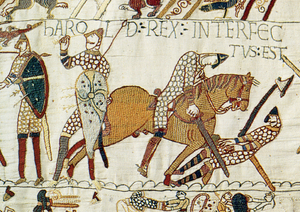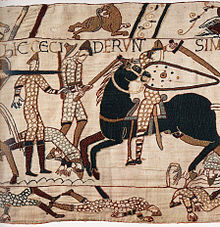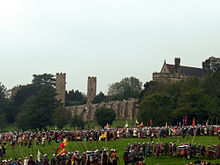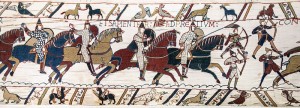Habitual History and the High Ground
By Paul Comben
I first visited Senlac Hill, by long tradition the accepted site of the battle of Hastings, more than thirty years ago. I went there because I wanted to see what is the most famous and important battlefield site in my country’s history. I passed through the imposing gate of Battle Abbey, stepped into the area of gravel paths and lawns beyond; and whatever anyone else in the vicinity was thinking on that pleasant summer’s day in 1980, I was there to live out the history, put myself in the line of the shield wall, and let the best part of one thousand years melt away.
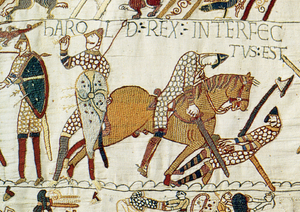
Harold Rex Interfectus Est: “King Harold is killed”.
Scene from the Bayeux Tapestry depicting the Battle of Hastings and the death of Harold – Wkipedia
And I tried; I tried very hard to see the brow of that hill to either side of me lined with a thousand largely blue and white shields. I tried to see six or seven thousand Normans and their allies in the fields before me; and above all else, I tried to bind to the earth beneath my feet, where fancy might imagine the powder of brave men long sifted into a dozen or more acres of Sussex ground; but though I stood there a long time, in truth, none of it, none of those Sussex acres, spoke a word to me.
Why?
Because, as I flatter myself I almost sensed I was not standing at the right place; in fact, as modern research is now strongly suggesting, it was nowhere near the battle site of Hastings at all. This is something historians should have known from ages ago, only they did not, preferring habit and received opinion over a scrap of decent analysis; and it is something one detailed war game design on the battle would have also brought to question… only it has never happened. The truth was hidden where next to no one saw it – in plain sight.
To spell things out, I could produce any number of the mainstream books written on the battle over the last fifty or sixty years and see just about the same thing in all of them: Harold’s army deployed on the top of Senlac Hill/the hill was steep enough to lessen the effectiveness of charging Norman cavalry/the Saxons were tight pressed in a shield wall/the flanks of Harold’s position were protected by steeper gradients which gave the Normans no option but to attack frontally etc etc. Frankly, the only thing correct in all that is that Harold was the Saxon king and his army did deploy; but not on Senlac hill.
In 1980, I was a young man who had been enjoying the simulation hobby for about eight years; but I had been reading books on this battle since I was five or six. I knew all the details of the accepted account, but coming face to face with both the place, and, in a sense, the event, none of it matched up. Just like Henry VIII had found the presented countenance of Anne of Cleves to be at odds with her portrait, so I found the story of this great battle to be in utter contradiction with its setting. And, in truth, it was more than just the setting; it was the supposed fighting method of the Saxon army as well, and of the military prowess of their king, one of the great warlords of Eleventh Century Europe, Harold Godwinson.
So let us come straight to the point: there are no steep sides to Senlac Hill. From the assumed centre of Harold’s position, walk a couple of hundred yards further east, where the Hastings-London road dips off the last of the ridge, and you will see pensioners of an advanced age ambling up and down a slope which we are meant to believe utterly deterred that other great warlord, Duke William, from attempting to flank and totally compromise the Saxon line. The notion that any part of Senlac Hill would degrade a Norman cavalry advance of a mere one hundred and fifty to two hundred yards, when horses go twice round the Aintree Grand National circuit and then often sprint it out at the end is drivel – lazy, habitual, disappointing drivel. And in addition to that, we are supposed to believe that the momentum of five hundred to a thousand mounted and mailed knights, was withstood from morning to late afternoon by a Saxon line standing at most ten deep. I only have to look at my own country’s history of riots since the 1960s to question that – Grosvenor Square’s anti-Vietnam War demonstrations, or the Poll Tax disturbances near the end of the Margaret Thatcher era, where in both cases mounted police were sent against crowds hundreds deep, and one saw those crowds give ground, part and sway as the horses advanced. Little wonder that at Crecy the English infantry line was protected by a belt of potholes, at Agincourt by sharpened stakes, at Poitiers by other significant natural obstacles – all defences against the mounted charge; all things we are supposed to believe Harold did without.
But Harold was a capable military man, and it flies in the face of his experience as a leader and a warrior, that, facing an army unlike any the Saxons had faced before, his one and only recourse was to stand on an utterly nondescript hill and trust that the Fyrd would soon adapt to the new battle realities, and that the Normans would not try anything too shifty. But, given that the battle did last almost all of the day, and that William came close to losing, Harold must have done something that was different, because if he had just set up in the same old style, it is hard to see how the battle could have lasted more than a couple of hours before the Saxons were routed.
And this is where the discipline of war game design can play a key role, if only we are not afraid to draw conclusions which may be at complete odds with the orthodoxy. For me, design is about making a working model of the event; it is, in our environment and in our terms, creating a mechanism of numerical and other qualitative gearings, allied to a range of functions and motive power which drives the event along the broad lines of historical permutations and feasibility. And if, in the course of sourcing our component materials from various “suppliers” (i.e. books as much as anything else) we find that the gears or some other fundamentals of our mechanism are not meshing together, then it is time to voice an opinion and get the debate going.
When it comes to Hastings, what this all means in practice is not allowing ourselves to be conned or cajoled into endowing a crest line with extraordinary powers, creating geography because some book or other did that, artificially constricting the map so that flank attacks fall off the edge of Middle Earth, or just assuming that a shield wall that was primarily meant to fight another shield wall is going to stand robust and resolute on a picnic slope as Norman cavalry comes pounding up against it. And speaking of shield walls, another issue heroically ignored in one Hastings book after another is how such a wall was maintained when accounts from early medieval times onwards (such as the account of the battle by the Norman, Wace) speak of the damage done to the Normans by the two handed axes of the Housecarls. Shields walls and two handed axes simply do not go together for reasons of pure commonsense.
There have not been that many games on Hastings over the years; but in truth, those we have seen have each fallen foul of the received opinions of histories which followed the old rutted path to error. Fundamentally, design is about understanding how any element works in a field of conflict, relating its strengths and weaknesses to the opposing force and the battle’s environment, and then assigning values and properties so that the model moves and performs within realistic and feasible parameters. So, just as one might consider something to have gone seriously awry if a lovingly constructed replica of a Sopwith Camel shoots off the runway at 300 MPH, or a model of the earliest telescope clearly picks out something millions of light years distant, we must be dubious about phantom gradients, superhuman endurances, three handed Housecarls, and Norman horses with less physical endurance than Oliver Hardy and an extreme fear of very small heights.
Why does it matter? Well, it matters to me because it is my history and I would like it done correctly; but beyond that, it matters because the hobby is shot through with brilliant people who can contribute much to a broader understanding of the best and the worst of human life as war has raged over centuries; but regrettably this is only intermittently done. John Prados and Joe Balkoski are the names that most readily come to my mind as examples of design excellence combining with the application of astute historical/analytic skill, but after that the list does seem to drop off. In fact, the only other name I could mention is that of Philip Sabin, who, in his design Lost Battles, offers something entirely new in the modelling both of the ancient battlefield and the armies that fought on it, and combines this with a conflict study teaching post within the British university system.
So, where was the battle of Hastings fought, if not at Senlac Hill? In recent years, momentum has slowly grown for the battle to be relocated to the village of Crowhurst, a short drive from Battle, but where the geography is entirely faithful to the ancient accounts, and where the battle has far greater facility to resemble how two differing armies led by capable commanders would have formed up acquitted themselves. In other words, this is the right box to be building and sourcing a Hastings simulation mechanism from.
Added to this, competent commanders, whether it is William landing in England or the panzer generals crossing the Meuse in 1940, tend to want to make that potentially vulnerable first move where the enemy is not. In histories of 1066, habit, and nothing more than habit, has placed the Norman landing at Pevensey. The problem is, not only would this have placed the Norman landing right under the heavily garrisoned walls of Pevensey castle, it also puts a large bay and marshland between William’s supposed base and the only route to the supposed battle site of Senlac Hill – and as William destroyed his fleet and was thus in no position to make a second boat journey even if he had wanted to, this and the proximity of the fort makes his landing there a military nonsense.
Another aspect to understanding this, drawn from our alternative box of bits, gears and levers, is that this part of the English coastline was vastly different in 1066 to how it is today, with much of the area being heavily indented with bays, inlets and saltwater marshes. Thanks to the research of the group SOTNI UK, (Secrets of the Norman Invasion) we have a much clearer idea where the earliest site of the port of Hastings was, where William almost certainly landed (Combe Haven), and where, along this bottleneck of land with marsh and sea to either side, Harold would have raised the Wessex Dragon and The Fighting Man, and made his stand.
Of course, much of this research is fairly new, but the faults and errors which disqualify the candidacy of Senlac Hill have always been there for people to see. In addition to those already presented in this article, it is worth adding that absolutely no archaeology has ever been found at the Battle Abbey/Senlac site to support the notion that a battle involving upwards of fifteen thousand men was ever fought there. No one has ever found so much as a few links of mail, some arrow heads, a shield boss…anything. Furthermore, key geographical features, such as the Malfosse (a large and deep ditch which caused chaos for pursuing Norman knights at the battle’s conclusion) are entirely absent from Senlac Hill’s environs. There is not the slightest trace of anything of the kind; and therefore it is such a shame if designers somehow feel obliged by the hand-me-downs of any work on any battle to perpetuate such errors by including features which simply do not belong where they are put.
Of course, it might be said that it is easier to dismantle one take on events than to assemble a cogent alternative. However, I firmly believe that creating a sound historical design is far more a skill of establishing the rapport of historical character and environment than waving some old bits of parchment about. Knowing the geography, the usages of formations and weaponry, and the character of a brave king and an imperturbable conqueror, will quantify a simulation unit/element far better than relying on whatever weak opinion went before… and, if needs be, like at Hastings, it will put events on the right field.
Another regrettable aspect of how this battle has been modeled in the past is that the more interesting nature of the “newer” candidate field has been denied by designs being lured into the easier fix. The likeliest Hastings battlefield, Crowhurst, was relatively narrow, and its flanks were properly defended by extensive natural ditches – including the forty foot drop of the true Malfosse, which would have been a little behind the Saxon left’s first line. This is a battlefield that a veteran commander like Harold would have chosen to deny cavalry some of its key advantages. Furthermore, by moving rapidly south from London (something which has constantly puzzled historians as it makes no sense when tied to the Senlac site), Harold at Crowhurst, on ground that was very much part of his own manor, was right across William’s only possible exit from his landing area to the London road. William, at the tip of a peninsula, therefore had to fight or starve. But the biggest difference in the two fields was the defenses the Saxons prepared against the Norman assault – not so much a shield wall as a wall of shields. Essentially, the Saxons built at least one line, and possibly two, of shields interlaced with wattle, staves and other materials, protected these further with a man-made ditch, which is not only the sort of thing an experienced commander of a foot army of very mixed quality is going to do when facing powerful cavalry, but also readily explains how the Saxons could wield those two handed weapons behind a shield wall. And anyone wanting to know how this appeared to the Normans should read the work of Wace, who spoke of how the Saxons “enclosed the field,” and then went on to describe rather graphically what those axes could do when they struck home.
So Hastings awaits its first faithful design; but it is not the only battle to be afflicted by poor and sloppy book research. Waterloo is another; but there it must be said that the attention paid in simulations to giving units their right characteristics and environment has significantly lessened the chances of odd things happening. Chief among the bad habits of Waterloo accounts is placing eighty or so French cannon hundreds of yards ahead of the main French line, where, entirely unsupported by so much as a regiment of cavalry, they were supposed to have blasted away at the forward positions of Wellington’s line prior to the attack by the divisions of D’Erlon’s I Corps.
Really?
And what is likely to happen in any decent Waterloo game if you nonchalantly seek to move ten or so unsupported artillery batteries to within six to eight hundred yards of the enemy line? Goodbye artillery. Nevertheless, it was only with the publication of Alessandro Barbero’s book on Waterloo a few years ago that this perpetual error was exposed, with Barbero arguing that the initial bombardment occurred from the original French line, and that the batteries subsequently destroyed by the British cavalry were those advancing and setting up in the wake of the I Corps’ actual advance. The working model of many a Waterloo game would surely affirm this, as the numerous book accounts of French batteries on the more advanced ridge from the start are essentially an invitation to simulation suicide. And I would argue that the events of October 14th 1066 need a similar dose of good historical engineering.
Paul Comben


